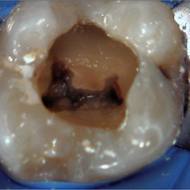ENDODONTICS
Root canal therapy for vital elements
It is the branch of dentistry that deals with the treatment of the endodontium – a space inside the tooth that contains the dental pulp. The endodontic therapy is used when a lesion (caries, traumatic) causes an alteration of the pulp tissue, which results in necrosis. It is also possible to use this method when the tooth has to be involved in prosthetic rehabilitations that, due to the considerable reduction of dental tissue (preparation of the tooth), lead to an increase of the residual sensitivity or irreversible alteration of the pulp (pulp necrosis due to iatrogenic causes).
Root canal therapy for necrotic elements
Following a carious process or in case of relapsing caries under a wider reconstruction, which affect the pulp chamber and determine necrosis, we are often forced to perform an endodontic treatment. These are the symptoms to determine if the pulp of a tooth is necrotic: thermal sensitivity test to cold with negative results and the tooth is extremely painful to percussion; the patient complains about a subjective sensation of “high tooth.” In this case the procedure is the same for all root canal therapy and if necessary before closing, the endodontic space is treated with the medical disinfectant substances that quickly reduce the symptoms described above.
Root canal retreatment
The endodontic retreatment is one of those practices that sometimes is more complex. The objectives of the retreatment are strictly identical to those obtained at the end of the endodontic treatment practiced on the untreated tooth (i.e. to have a devitalized tooth at the end, but without lesions at the apex), and the necessity and the causes of root canal retreatment can be very different. The presence of a persistent periapical lesion that has been radiographically identified, accompanied by pain and/or recurring abscess, is often considered an absolute indication for surgery.
The cause of most of the failures of the endodontic treatment is an inadequate apical seal. In this case, the non-surgical endodontic treatment is often preferred to surgery or extraction. The removal of the previously placed root canal filling, a difficult and tedious procedure, and the creation of a new apical seal are the requirements for a successful retreatment. This type of treatment is not always possible if not removable cements or pins were placed within the canal.
Endodontic surgery and apicectomy
In the presence of lesions of endodontic origin that do not respond to conventional endodontic therapy or which cannot be treated because the access to the canal is no longer possible due to the presence of crowns, root canal pins or foreign bodies, then the lesion shall be removed via endodontic surgery. It is necessary to understand the causes that led to the failure to assess whether it is possible to correct the problem with an orthograde retreatment. Many authors agree that surgical endodontics should not replace an approximate endodontics and should not be a loophole to leave an inadequate endodontic therapy “untreated”.
The endodontic surgery is followed by the apical removal of 3-4 mm of a root of the tooth. It is not appropriate to perform an apicectomy when the roots of the tooth are too short to hold a further shortening, when the root/roots is/are fractured or when the tooth is to be extracted.
Endodontic surgery and apicectomy
In the presence of lesions of endodontic origin that do not respond to conventional endodontic therapy or which cannot be treated because the access to the canal is no longer possible due to the presence of crowns, root canal pins or foreign bodies, then the lesion shall be removed via endodontic surgery. It is necessary to understand the causes that led to the failure to assess whether it is possible to correct the problem with an orthograde retreatment. Many authors agree that surgical endodontics should not replace an approximate endodontics and should not be a loophole to leave an inadequate endodontic therapy “untreated”.
The endodontic surgery is followed by the apical removal of 3-4 mm of a root of the tooth. It is not appropriate to perform an apicectomy when the roots of the tooth are too short to hold a further shortening, when the root/roots is/are fractured or when the tooth is to be extracted.

